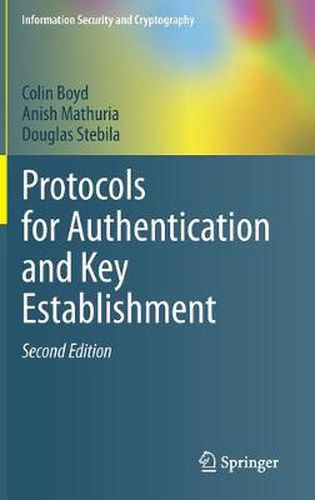Readings Newsletter
Become a Readings Member to make your shopping experience even easier.
Sign in or sign up for free!
You’re not far away from qualifying for FREE standard shipping within Australia
You’ve qualified for FREE standard shipping within Australia
The cart is loading…






This title is printed to order. This book may have been self-published. If so, we cannot guarantee the quality of the content. In the main most books will have gone through the editing process however some may not. We therefore suggest that you be aware of this before ordering this book. If in doubt check either the author or publisher’s details as we are unable to accept any returns unless they are faulty. Please contact us if you have any questions.
This book is the most comprehensive and integrated treatment of the protocols required for authentication and key establishment. In a clear, uniform presentation the authors classify most protocols in terms of their properties and resource requirements, and describe all the main attack types, so the reader can quickly evaluate protocols for particular applications.
In this edition the authors introduced new chapters and updated the text throughout in response to new developments and updated standards. The first chapter, an introduction to authentication and key establishment, provides the necessary background on cryptography, attack scenarios, and protocol goals. A new chapter, computational security models, describes computational models for key exchange and authentication and will help readers understand what a computational proof provides and how to compare the different computational models in use. In the subsequent chapters the authors explain protocols that use shared key cryptography, authentication and key transport using public key cryptography, key agreement protocols, the Transport Layer Security protocol, identity-based key agreement, password-based protocols, and group key establishment.
The book is a suitable graduate-level introduction, and a reference and overview for researchers and practitioners with 225 concrete protocols described. In the appendices the authors list and summarize the relevant standards, linking them to the main book text when appropriate, and they offer a short tutorial on how to build a key establishment protocol. The book also includes a list of protocols, a list of attacks, a summary of the notation used in the book, general and protocol indexes, and an extensive bibliography.
$9.00 standard shipping within Australia
FREE standard shipping within Australia for orders over $100.00
Express & International shipping calculated at checkout
This title is printed to order. This book may have been self-published. If so, we cannot guarantee the quality of the content. In the main most books will have gone through the editing process however some may not. We therefore suggest that you be aware of this before ordering this book. If in doubt check either the author or publisher’s details as we are unable to accept any returns unless they are faulty. Please contact us if you have any questions.
This book is the most comprehensive and integrated treatment of the protocols required for authentication and key establishment. In a clear, uniform presentation the authors classify most protocols in terms of their properties and resource requirements, and describe all the main attack types, so the reader can quickly evaluate protocols for particular applications.
In this edition the authors introduced new chapters and updated the text throughout in response to new developments and updated standards. The first chapter, an introduction to authentication and key establishment, provides the necessary background on cryptography, attack scenarios, and protocol goals. A new chapter, computational security models, describes computational models for key exchange and authentication and will help readers understand what a computational proof provides and how to compare the different computational models in use. In the subsequent chapters the authors explain protocols that use shared key cryptography, authentication and key transport using public key cryptography, key agreement protocols, the Transport Layer Security protocol, identity-based key agreement, password-based protocols, and group key establishment.
The book is a suitable graduate-level introduction, and a reference and overview for researchers and practitioners with 225 concrete protocols described. In the appendices the authors list and summarize the relevant standards, linking them to the main book text when appropriate, and they offer a short tutorial on how to build a key establishment protocol. The book also includes a list of protocols, a list of attacks, a summary of the notation used in the book, general and protocol indexes, and an extensive bibliography.